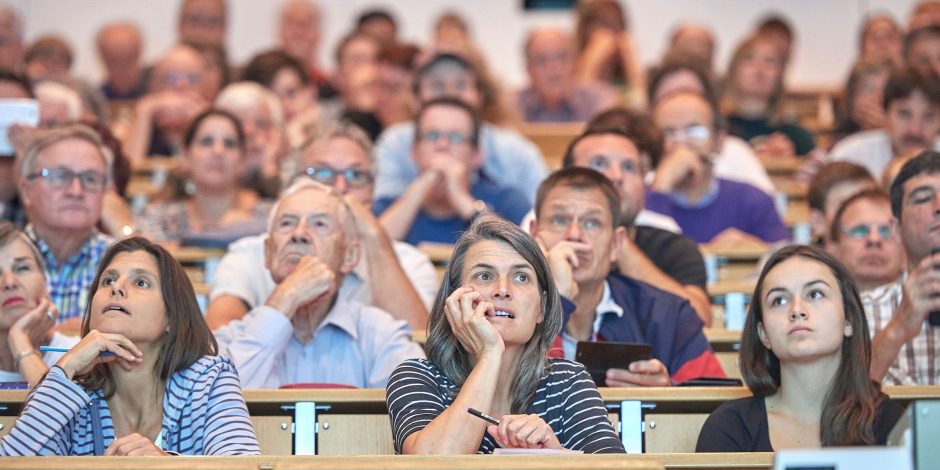“Rosetta found an interesting place to die”

At the University of Bern about 300 guests and the Swiss media followed the end of the spacecraft Rosetta that was manoeuvred to crash on comet Churyumov-Gerasimenko.
University of Bern, 30 September 2016, 13:17 CEST: In a big lecture hall filled to capacity the researchers and speakers Nicolas Thomas and Martin Rubin are getting nervous. They are watching a signal that is broadcasted from the European Space Operation Centre ESOC in Darmstadt – a curve with a pronounced peak in the middle, the sign that Rosetta is still alive. In one minute the spacecraft should crash on its comet and the peak should disappear.
13:18 CEST: Nothing happens. “Come on!” Nicolas Thomas shouts. Together with his team he analysed images of the OSIRIS camera system aboard Rosetta, whereas Martin Rubin was part of the team that built the ROSINA instrument to determine the composition of the comet. TV and photo cameras are focussed on the two researchers waiting for big emotions. Forty minutes ago, ROSINA Principal Investigator Kathrin Altwegg following the grand finale at ESOC had informed the audience in Bern via skype that the calculated time of touch down had an uncertainty margin of plus-minus two minutes.
13:19 CEST: Finally, there is no peak any more. “We physicists love bangs”, Nicolas Thomas had stated an hour ago, but now it takes some time for the big smile to arrive. And although the public is applauding there seems to be a kind of melancholy in the air. After all, it was a sudden death that everybody just witnessed. “But Rosetta found an interesting place to die”, Nicolas Thomas comforts the audience and himself.
Actually, a first look at the last pictures reveals a very rough surface with lots of little stones. “They were probably thrown up by the activity on the comet and landed back on the surface,” explains Nicolas Thomas. Not only the camera but also ROSINA’s pressure sensor functioned perfectly. “The last valid measurement of ROSINA was taken about one minute before the crash”, reports Martin Rubin: “It showed a gas pressure of 2,26 x 10-8 millibar.” Rosetta’s data will keep the researchers busy for years, and although the mission is over Bern space research is already looking forward to another highlight. On 19 October the ExoMars Trace Gas Orbiter with the Colour and Stereo Surface Imaging System, CaSSIS, will enter orbit around Mars. “First images are expected in November,” Nicolas Thomas explains. (bva)
Media Release of the University of Bern
Categories: News

